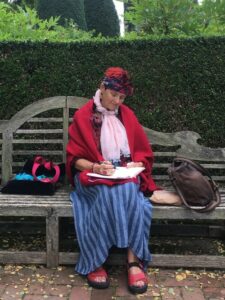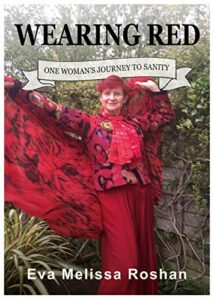
JANE BURN – POETRY AS HARD GRAFT, INSPIRATION, REACTION OR EXPERIMENT?
I interviewed poet & artist Jane Burn who won the Michael Marks Environmental Poet of the Year 2023-24 with A Thousand Miles from the Sea.


Interview with Eva Melissa Roshan red-headed writer, poet and author of her first published book, ‘Wearing Red-One Woman’s Journey to Sanity.’ Eva’s life-affirming story reveals how she has overcome childhood sexual abuse, alcohol and debt addiction, divorce, depression and self-abuse. She vividly portrays living with bi-polar mood swings, and how she healed herself by creating a beneficial relationship with her demons.
Leslie: Tell us about the writing process that went into your book, ’Wearing Red- One Woman’s Journey to Sanity.’
Eva: I wrote ‘Wearing Red’ to show that it is possible to survive tragic circumstances, to come out the other side and create a successful life of integrity, dignity and self-respect.
The book is my life-affirming story of courage and hope, told in vignettes of defining moments. It reveals how as a child I was sexually abused by my father. How as an adult I experienced alcohol and debt addiction, living with bi-polar mood swings. And most important of all, how I found the courage, wisdom and strength to overcome all of this and forge a new, thriving life for myself.
To aid my memory, I used information from old journals, photographs and conversation records that I had kept during my recovery journey.
I opted not to write in chronological order as this felt too linear and not in keeping with the chaos of my early life. If I had tried to do that, I don’t think I’d have finished the book. I just delved into a particular section or poem theme and let the writing take over.
It was important for me to banish my inner critic and just focus on getting my first draft down, word by word, story by story, in free-flow style. When my critic voice appeared, I fetched her a cup of tea and told her she could come out later when I’d finished!
I chose to use a mixture of poetry and prose, being led by the feelings around each portion of the story. I found poetry more helpful in conveying the emotions involved and the frenetic nature of mood swings.
In my writing, I drew on Homer’s stories of Persephone and Sisyphus to deepen my understanding of what happened to me. I also re-wrote the stories. At the final editing stage, I chose not to include these sections, but my writing was enhanced as a result of the insight gained.
 Stepping out of memoir mode at the end of the book, I included a chapter containing some of my own mental well-being tool kits, which have helped me sustain my own recovery and live with mood fluctuations, on a daily basis. A manual of self-care as encouragement to others, on how to stay well.
Stepping out of memoir mode at the end of the book, I included a chapter containing some of my own mental well-being tool kits, which have helped me sustain my own recovery and live with mood fluctuations, on a daily basis. A manual of self-care as encouragement to others, on how to stay well.
I had an excellent writing mentor in Barbara Bloomfield. Having someone at my back, pushing me forward so that I kept going when I thought of giving up, was essential to my process. She supported me through the gremlins of doubt.
Leslie: Where does your willingness to describe the unvarnished realism of mental health experiences come from?
Eva: I was very clear in my mind about my purpose. I wrote ‘Wearing red’ for publication, to support others and to become a testimony to the power of releasing secrets, speaking out and being heard. Part of the ‘Me Too’ and ‘Time to Change.’ movements to prevent the abuse of children and adults by those in positions of authority.
I am passionate about changing mental health attitudes and reducing the stigma attached to sexual abuse and addiction. These are often considered taboo subjects to talk about and that needs to change, in my opinion.
The only power I have today is to do my best to ensure that the vicious cycle of abuse is not passed on. In order to recover, I made a choice to embrace my history and reconcile myself with the past. Writing this book has been an integral part of this process.
In ‘Bird by Bird’ Anne Lamott says: ‘Writing a memoir is like allowing your truth to escape from jail.’ I think this is the quote that kept me going over the four years that it took me to finish my book.
If ‘Wearing Red’ gives others the courage to find their voice; to recover from shame, addiction, mental health challenges and being locked into the secret of childhood abuse, then I have achieved a goal.
Leslie: How have you felt about baring your soul?
Eva: I am proud of the fact that I developed the courage to find my voice and write my truth. It became an empowering process, which helped me accept my past and my mood swings.
I had a story to tell that I considered worth telling in the hope that this would also be of benefit to others, with similar experiences. A story of change and transformation.
No less significant, another purpose was for the book to become a gift to myself. So, I can proclaim loudly- ‘Yes, I did this’- I spoke out and told my secret and fulfilled half-finished promises in the process.
It was such a thrill to write about one of the most significant transitions in my life, which was re-naming myself to cut the ties with my past. The highest honour I gave myself was to re-assign my own identity in an empowering and honouring way. I carefully chose a new name – Eva Melissa Roshan. I celebrated the significance of this momentous change in my life by having a special ritual naming ceremony to welcome in the birth of Eva.
My Chippewa ancestors would have been proud of me, as they had a tradition of re-naming themselves at important transitional life stages. My great, great grandmother was the daughter of a Chippewa Chief, who married an English trader who ran salt boats to America.
I did have a brief bout of troubling anxiety immediately after the book was published, as my past had come into my present in such a public way. I had to take some medication short term to support me through this period and guided myself with mindfulness techniques to alleviate the disquiet.
Thankfully, this passed and I was able to enjoy the process of launching the book.
I was able to remind myself that I am a powerful and capable woman. A professional in my own right, who has refused to be defined by the things that happened to me in my past. Regardless of the odds stacked against me, I have successfully reclaimed my sanity.
Overall, it was an inspirational and freeing act to tell my story in this way and I haven’t regretted my decision.
Leslie: How did your bi-polar experiences begin, grow and develop? Looking back what helped and hindered you from dealing with them?

Eva: My bi-polar experiences began in my teens and developed over the years. They played a huge part in my debt addiction, as during the highs I would spend vast amounts of money and convince myself I had the grandiose abilities to settle the amounts owing. When I sought help for this addiction, and faced the reality of my situation, we had to remortgage the house to pay off all the credit card bills and loans.
For years I did my best to manage my mood swings with the aid of therapy and the various well-being tool kits I’d developed. This became increasingly harder as the years went by.
Having discussed my mood swings with a psychiatrist, a couple of years ago, he suggested that I have bipolar II, which is a milder version than bipolar I. I’m now taking a mood stabiliser, so the low periods have less ability to poleaxe me. In this way the highs are also contained.
He also thought that the childhood sexual abuse had activated the bipolar/cyclothymic gene I’d inherited from my mother. I’m not a fan of labels, but today I can perceive a diagnosis as a way of understanding myself better, rather than as a box that defines me and excludes crucial parts of myself.
Learning to develop some kind of relationship with my darkness has helped me in dealing with my extreme mood swings. Owning the parts of myself that aren’t shiny.
This required adopting a new way of living, which demanded I treat myself with respect and compassion.
I’ve become more realistic about how to adapt socially in order to live a more fulfilling life. Withdrawing into the underworld does offer some protection, when I need to regroup, or plot a different course. Falsely trying to cheer myself up rarely works.
I no longer perceive my mood swings as a curse I’m stuck with. I refuse to be defined by them or the label bi-polar.
Without doubt, I’ve been blessed in finding my loving and creative partner Jonny, who as my husband has stood by me all these years. I must have done something right to have deserved all that this relationship has given me.
Most of the time I’m comfortable in my own skin and the medication I take has helped this materialise.
If I had a choice, or magic wand would I rather be a person without my emotional volatility? Probably…Perhaps…I don’t know.
What I do know is that I no longer abuse myself. I am no longer a victim. I have moved beyond survival.
Leslie: In your writing, what are the metaphors you use for mental illness? Why them? How can metaphors help the recovery/adaptation process?
Eva: My title, ‘Wearing Red’ is a significant metaphor. As a person who loves wearing brightly coloured clothes, I find that wearing red helps me walk tall and feel ok in my own skin. The colour fuels my energy and vitality and has been of benefit in my journey to sanity. I refer to this a lot in the book and explore what I call ‘growing up with crazy’ and the link with ‘wearing red.’
Metaphors of colour are used in the book to signify diverse levels of mood swings. There is a great deal of significance in the choices we make around colour. During the Second World War, the government was aware of the psychological research that bright colours can have a positive effect on our emotions. Their argument was that wearing grey or black would make us feel low and defeated. Whereas wearing brighter colours like red would make us feel better about ourselves and would help people feel confident about victory being possible. Their propaganda message was ‘Wear bright colours and we can win the war.’
Leslie: Were there any models that helped you to write this book?
Eva: I devoured lots of memoirs which helped my writing process by considering various styles, then I simply had to choose my own way of writing my story.
I also read tons of ‘how to write memoir’ books, which soon became an obsession. I filled my shelves with them but didn’t start writing. Eventually I chose just one – Natalie Goldberg’s ‘Old Friend from Far Away’ as my guide and worked my way through her exercises, which acted as prompts.
I also kept the books of Anne Lamott by my side and dipped into them. She has an honest and humorous way of telling stories about her life and recovery journey.
Leslie: What do you consider to be your signature style as a writer? How are you trying to extend yourself/cover new ground in your next book?
Eva: My signature style is still emerging, but my favourite way of writing is free flow, with an autobiographical element. I write a lot of prose-poetry and may produce a poetry anthology eventually.
My next book is developing from the weekly mental well-being tips that I write about on the blog page of my website – Blog — Eva Melissa Roshan (evaroshan.com). They are intended as a support to others in managing mood swings; creating some level of balance in life; making healthy choices and enriching daily experiences.
I’ve received such encouraging feedback about the value of these blogs to others that I’m compiling them into a book, with a working title ‘ Staying Afloat.’ It will contain 365 reflections, insights and tools on self-care.
After that, who knows?… I have a passion for mythology and may cover new ground re-writing the stories of Persephone and Sisyphus and other mythological characters.
ABOUT LESLIE TATE’S BOOKS:

I interviewed poet & artist Jane Burn who won the Michael Marks Environmental Poet of the Year 2023-24 with A Thousand Miles from the Sea.

I interviewed ex-broadcaster and poet Polly Oliver about oral and visual poetry, her compositional methods, and learning the Welsh language. Polly says, “I absolutely love

I interviewed Jo Howell who says about herself: “I’ve been a professional photographic artist since I left Uni in 2009. I am a cyanotype specialist.


Poet Tracey Rhys, writer of Teaching a Bird to Sing and winner of the Poetry Archive’s video competition reviews Ways To Be Equally Human. Tracey,
| Cookie | Duration | Description |
|---|---|---|
| cookielawinfo-checkbox-analytics | 11 months | This cookie is set by GDPR Cookie Consent plugin. The cookie is used to store the user consent for the cookies in the category "Analytics". |
| cookielawinfo-checkbox-functional | 11 months | The cookie is set by GDPR cookie consent to record the user consent for the cookies in the category "Functional". |
| cookielawinfo-checkbox-necessary | 11 months | This cookie is set by GDPR Cookie Consent plugin. The cookies is used to store the user consent for the cookies in the category "Necessary". |
| cookielawinfo-checkbox-others | 11 months | This cookie is set by GDPR Cookie Consent plugin. The cookie is used to store the user consent for the cookies in the category "Other. |
| cookielawinfo-checkbox-performance | 11 months | This cookie is set by GDPR Cookie Consent plugin. The cookie is used to store the user consent for the cookies in the category "Performance". |
| viewed_cookie_policy | 11 months | The cookie is set by the GDPR Cookie Consent plugin and is used to store whether or not user has consented to the use of cookies. It does not store any personal data. |